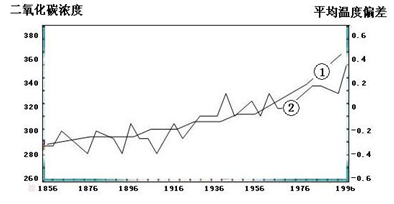阅读下列材料,完成下列问题。(8分)
材料一 印度尼西亚巴厘岛联合国气候变化大会孕育出备受瞩目的“巴厘岛路线图”。该路线图第一项第一款指出,依照“共同但有区别的责任”原则,考虑社会、经济条件以及其他相关因素,与会各方同意长期合作,共同行动,把“减排温室气体”作为全球长期目标。
材料二:二氧化碳浓度变化与大气平均温度偏差的相关性

(1)材料一中“巴厘岛路线图”第一项第一款指出的内容体现了可持续发展的 原则。(2分)
(2)材料一中“共同但有区别的责任”的含义是什么?(2分)
(3)材料二中①、②两条曲线中,表示二氧化碳浓度的是 ,表示平均温度偏差的是
(2分)
(4)企鹅是南极大陆最有代表性的动物,被视为南极的象征。而企鹅的原栖息地遭到破坏,迫使企鹅不断往高处迁移,其数量也越来越少。试分析产生上述现象的原因。(2分)
(1)共同性
(2)气候变化会对地球生态系统和人类产生不良影响,应对气候变化是全人类共同的责任,根据公平性原则,造成全球污染份额大的发达国家应当承担更大的责任。
(3)① ②
(4)全球 CO2 气体含量增多,气温升高,冰川融化;南极上空出现臭氧空洞,对生物造成 危害;人类对企鹅的捕杀。
本题考查全球气候变化和可持续发展。
(1)“共同但有区别的责任”原则反映共同性原则。
(2)共同主要指:应对全球气候变化需全球共同合作;有区别主要是指发达国家和发展中国家承担的责任有区别。
(3)全球二氧化碳浓度持续升高,而全球气温呈波动上升状况。
(4)主要从其栖息环境的破坏:全球变暖引起的海平面上升和部分极冰融化、及南极臭氧空洞和人类直接的影响等角度分析。
